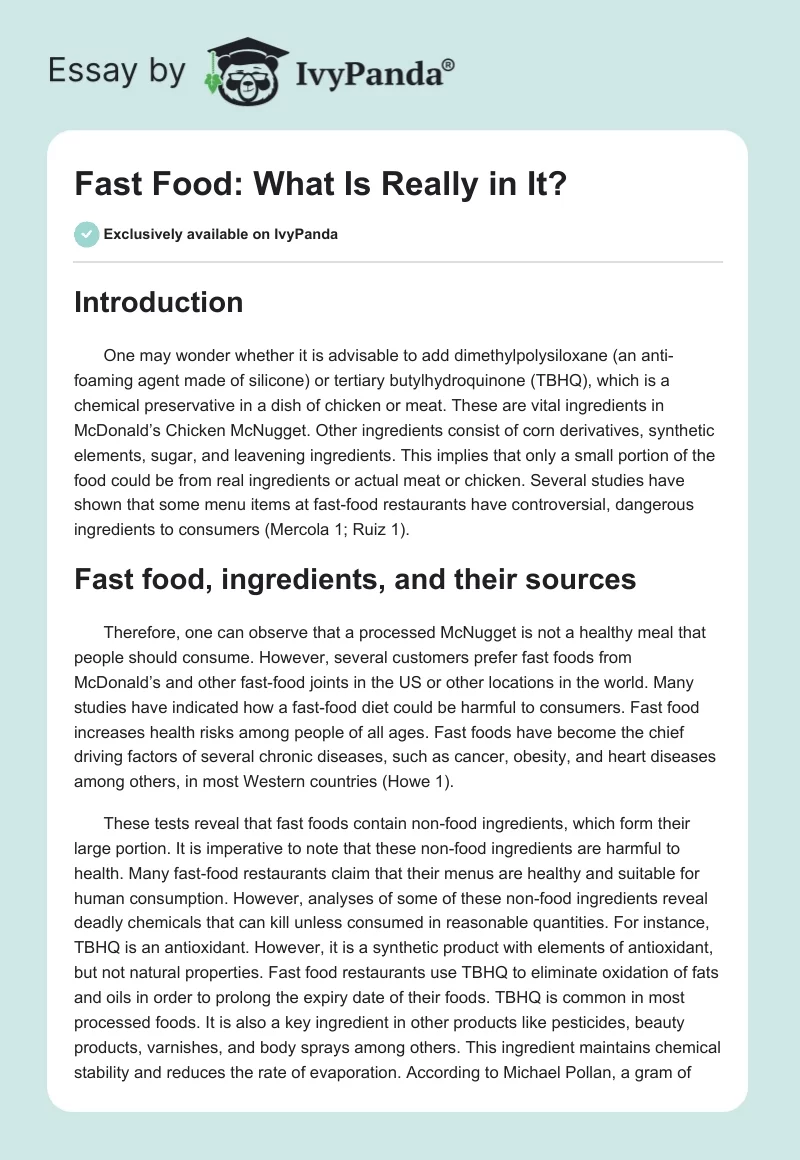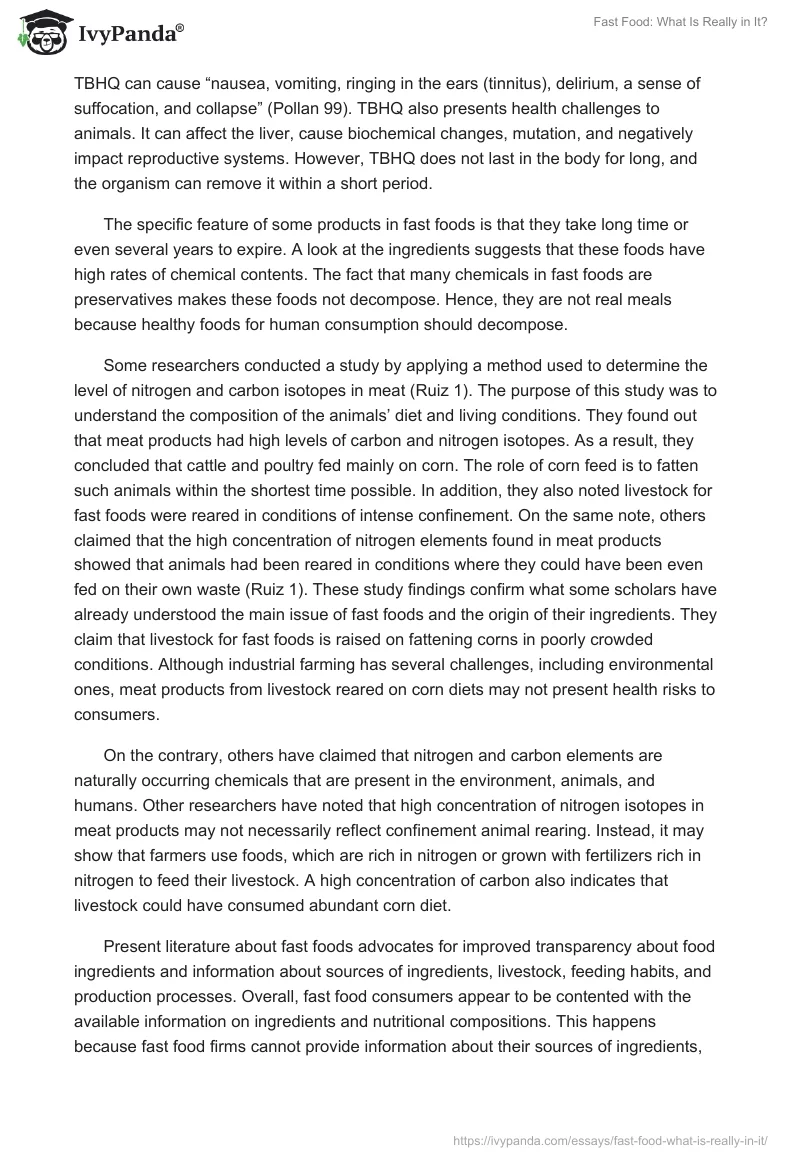Introduction
One may wonder whether it is advisable to add dimethylpolysiloxane (an anti-foaming agent made of silicone) or tertiary butylhydroquinone (TBHQ), which is a chemical preservative in a dish of chicken or meat. These are vital ingredients in McDonald’s Chicken McNugget. Other ingredients consist of corn derivatives, synthetic elements, sugar, and leavening ingredients. This implies that only a small portion of the food could be from real ingredients or actual meat or chicken. Several studies have shown that some menu items at fast-food restaurants have controversial, dangerous ingredients to consumers (Mercola 1; Ruiz 1).
Fast food, ingredients, and their sources
Therefore, one can observe that a processed McNugget is not a healthy meal that people should consume. However, several customers prefer fast foods from McDonald’s and other fast-food joints in the US or other locations in the world. Many studies have indicated how a fast-food diet could be harmful to consumers. Fast food increases health risks among people of all ages. Fast foods have become the chief driving factors of several chronic diseases, such as cancer, obesity, and heart diseases among others, in most Western countries (Howe 1).
These tests reveal that fast foods contain non-food ingredients, which form their large portion. It is imperative to note that these non-food ingredients are harmful to health. Many fast-food restaurants claim that their menus are healthy and suitable for human consumption. However, analyses of some of these non-food ingredients reveal deadly chemicals that can kill unless consumed in reasonable quantities. For instance, TBHQ is an antioxidant. However, it is a synthetic product with elements of antioxidant, but not natural properties. Fast food restaurants use TBHQ to eliminate oxidation of fats and oils in order to prolong the expiry date of their foods. TBHQ is common in most processed foods. It is also a key ingredient in other products like pesticides, beauty products, varnishes, and body sprays among others. This ingredient maintains chemical stability and reduces the rate of evaporation. According to Michael Pollan, a gram of TBHQ can cause “nausea, vomiting, ringing in the ears (tinnitus), delirium, a sense of suffocation, and collapse” (Pollan 99). TBHQ also presents health challenges to animals. It can affect the liver, cause biochemical changes, mutation, and negatively impact reproductive systems. However, TBHQ does not last in the body for long, and the organism can remove it within a short period.
The specific feature of some products in fast foods is that they take long time or even several years to expire. A look at the ingredients suggests that these foods have high rates of chemical contents. The fact that many chemicals in fast foods are preservatives makes these foods not decompose. Hence, they are not real meals because healthy foods for human consumption should decompose.
Some researchers conducted a study by applying a method used to determine the level of nitrogen and carbon isotopes in meat (Ruiz 1). The purpose of this study was to understand the composition of the animals’ diet and living conditions. They found out that meat products had high levels of carbon and nitrogen isotopes. As a result, they concluded that cattle and poultry fed mainly on corn. The role of corn feed is to fatten such animals within the shortest time possible. In addition, they also noted livestock for fast foods were reared in conditions of intense confinement. On the same note, others claimed that the high concentration of nitrogen elements found in meat products showed that animals had been reared in conditions where they could have been even fed on their own waste (Ruiz 1). These study findings confirm what some scholars have already understood the main issue of fast foods and the origin of their ingredients. They claim that livestock for fast foods is raised on fattening corns in poorly crowded conditions. Although industrial farming has several challenges, including environmental ones, meat products from livestock reared on corn diets may not present health risks to consumers.
On the contrary, others have claimed that nitrogen and carbon elements are naturally occurring chemicals that are present in the environment, animals, and humans. Other researchers have noted that high concentration of nitrogen isotopes in meat products may not necessarily reflect confinement animal rearing. Instead, it may show that farmers use foods, which are rich in nitrogen or grown with fertilizers rich in nitrogen to feed their livestock. A high concentration of carbon also indicates that livestock could have consumed abundant corn diet.
Present literature about fast foods advocates for improved transparency about food ingredients and information about sources of ingredients, livestock, feeding habits, and production processes. Overall, fast food consumers appear to be contented with the available information on ingredients and nutritional compositions. This happens because fast food firms cannot provide information about their sources of ingredients, suppliers, or food production processes due to competitive nature of the fast-food industry.
Controversies also follow fast food nutritional information provided on the packages. For instance, an article in Consumer Reports noted discrepancies between actual outcomes of their tests and information provided on the package (Fast Food for Fat-watchers 574). They noted that variations were as large as 20 percent while fat and oil differences exceeded this range of 20 percent. Surprisingly, the US Food and Drug Administration similarly proposed these ranges to allow small quantities of dimethylpolysiloxane and tertiary butylhydroquinone on chicken McNugget.
Consumers of fast foods increased in numbers, thus the consumption of fast food meals also raised, as Pollan noted (Pollan 104). This explains why fast-food chains have supersized items on their menus. The industry also expands rapidly but remains artificial as Jessica Grose observes in A Franchise of Their Own (Grose 90).
Conclusion
The article shows that fast foods contain harmful ingredients, which are not fit for human consumption. Hence, people who want to stay healthy and protect their children against obesity and other chronic illness must avoid fast foods and processed foods (Howe 16). Such people must prepare their meals. Many people want to consume a healthy diet, which is whole, organic, raw, and grown in healthy environments. Hence, some consumers have turned to vegetables because of their health benefits. Vegetables tend to have low levels of carbohydrates and do not interfere with insulin metabolism. Nevertheless, people should find the right diets based on their nutritional types.
Given such harmful chemicals in fast foods, it is advisable to make home-cooked foods for health benefits. Moreover, changes in diets could present serious alterations in epigenetic DNA, which could even affect future generations. Fast food consumers can break from consuming unhealthy foods by educating themselves in ingredients, their properties, and their effects on humans (Howe 1). Moreover, they can also plan their diets, take healthy snacks, and convince themselves to drop fast foods. All it takes is making a wise decision about fast foods.
Works Cited
“Fast Food for Fat-watchers.” Consumer Reports (1993): 574-578. Print.
Grose, Jessica. “A Franchise Of Their Own.” Bloomberg Businessweek 4330 (2013): 90. Print.
Howe, D. K. “Reality Bites.” American Fitness Magazine (2008): 16. Print.
Mercola, Joseph. “What’s in Fast Food? What’s in the Non-Chicken Half of the McNugget”. The Huffington Post. 2011. huffingtonpost.com Web.
Pollan, Michael. The Omnivore’s Dilemma: A Natural History of Four Meals. London: Penguin Press, 2006. Print.
Ruiz, Rebecca. “What’s Really In Your Fast Food?”Forbes. 2008. forbes.com Web.


